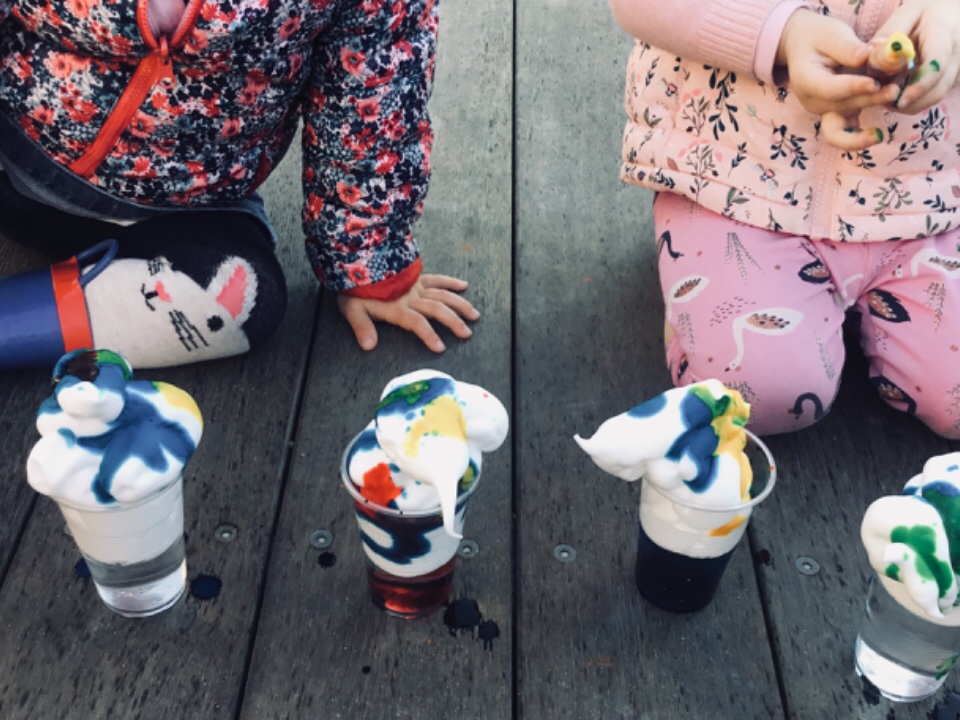Shaving Cream Rain Clouds
- Sophia Vidovic White
- Feb 24, 2019
- 3 min read
Monday 4th June 2018
This month, we are focusing our attention on the changing weather with an experiment that looks into how rain clouds form and function. We saw this experience as an opportunity to explain how rain and storms occur. With our recent conversations as we look out the window, involve discussing the shape and size of clouds and how they vary in shades of grey and blue. This led to our activity presented today.
Now you may ask yourself….What are clouds?
Clouds are droplets of water and crystals of ice, the exact composition depends on the temperature. Clouds form when warm air rises, expands and cools. Water molecules then attach to dust, pollution and smoke particles. When these molecules come together they form a cloud. Clouds float because the water droplets forming them are warmed up by the heat from the sun and warm air rises. The altitude at which clouds form depends on lots of factors such as air temperature, wind and size of the cloud. When a rain cloud reaches a certain mass the water needs to escape and so breaks through the cloud to fall as rain.
Instead of simply providing an explanation, we presented the children with open-ended questions.
We asked:
+ How does rain fall from the sky? How does it fall on you?
+ Where does rain come from?
+Why does it rain?
For our activity today, we gathered a few items from the supermarket that include:
+ A couple of clear glasses and cups (it’s fun to switch up the shapes and sizes)
+ Food colouring
+ Shaving cream
+ Small bowls or containers
+ Water
+ A 1/4 teaspoon measuring spoon
We began by filling the small cups with water. We noticed that the less water we used and the more concentrated the food colouring, the faster our “rain” will drop. On the other hand, the more water we used, the more rain we were able to make. We added various colours of food dye to each of the small containers. Our containers held about half a cup of water and we added ten drops of food colouring.
We then added a generous amount of shaving cream and used the teaspoon to drop the different colours of water onto the shaving cream cloud. We discovered the closer we added the food dye to the edges of the glass, the faster it will go through the shaving cream and come down as rain.
To explain the concept of rain we said that water is like air (the atmosphere) and the shaving cream are the clouds. As the clouds become saturated with water, they then begin to produce rain. We found that using rain as a visual representation was effective as the children could observe the weight of the food colouring pushing through the shaving cream and falling down through the water that’s in the glass. From our vision, it looked like streaks of rain falling.
From the questions we asked we found that explaining this concept using simple and familiar language, helped the children make a connection between what was happening in the experiment and comparing this with what they saw within their own environment. Gus Said “It’s like up there…the clouds in the sky“ June observed “The cloud is too big, the colour can’t go into the water“ When we added more water and less shaving foam Teddy said “Go down in water. Here. It’s blue.” We noticed the food dye dispersing more quickly through the foam. “It’s raining, you put the colour here…push in.” Said Ava as she tried to describe that adding food dye to the edges of the cup around the foam, meant that the colour would reach the water quicker. Sophie P and Ava tried using many colours and watched them merge and form a rainbow on top of the cup. However the colours mixed into a dark colour on the bottom of the cup. “Ice cream.” Said Sophie P
To expand on learning we may merge into explaining other aspects of weather with flooding, wind and the water cycle and where the water goes when it falls onto earth.




























Comments